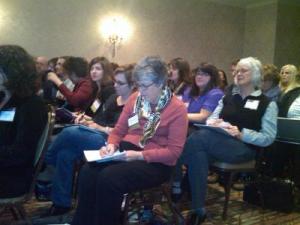More on this morning's session, "How to be an effective science PIO in the changing media world." This time, we hear about PIOs on the panel.
By Renee Twombly
It was clear from the PIOs on the panel that the hundreds of emails that Don and Ivan are ritually rejecting en masse every day from did not come from them. In fact, Don and Ivan — and the media in general — may be increasingly superfluous to the job these PIOs see themselves doing.
Earle Holland, for one, puts the media third down on his list of whom PIOs should pay homage to. The first two are the public and science (in general?), and the fourth is the institution that the PIO works for – Ohio State in Earle’s case. Earle called himself the dinosaur on the panel not only because he has been at Ohio State for 32 years, but because he believes that telling good stories about science is the goal of a PIO – which makes science writing the news media’s peer. Earle said his is not a “pitch shop” in that it is “very, very rare” for them to pitch a story to anybody. In fact, he says, their news releases are not strategically sent out but rather “thrown to the wind” …Steve Cole, a public affairs specialist for NASA, spends an increasing amount of his time reaching the public directly. He tweets twice daily on NASA’s Twitter feed, which has 600,000 followers, he produces “visuals,” and he has narrated videos for NASA TV, which are available on cable and YouTube. The new expectation at NASA is that their PIOs are the media, Steve said.
Joe Bonner, from Rockefeller, has a bit of a tougher job, perhaps, than Steve: “We cure a lot of diseases in mice,” he told the overflow crowd. Because of that, he makes a point of establishing a relationship with the science media (and beaucoup others) through extensive use of social media. His tools include Twitter, Facebook, and Linked In, of course, but also Google Reader and RSS to exchange info and learn from others. He communicates with Ivan but through Twitter.



